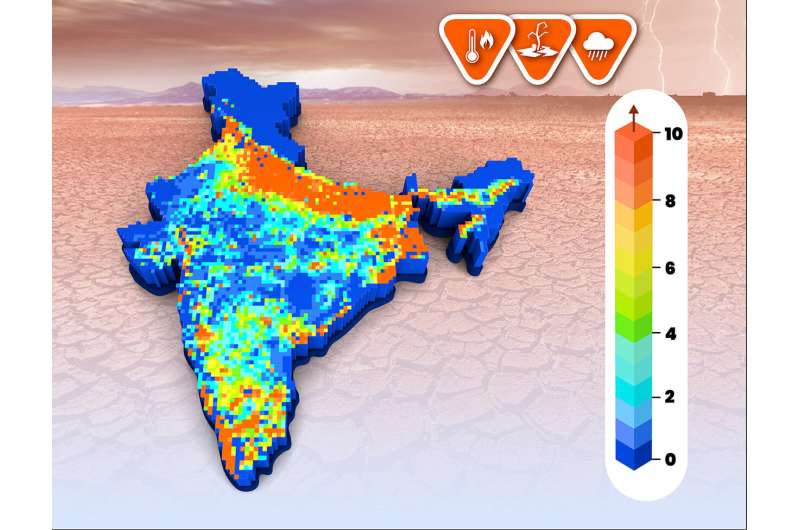This article has been reviewed according to Science X's editorial process and policies. Editors have highlighted the following attributes while ensuring the content's credibility:
fact-checked
trusted source
proofread
Research suggests that part of India will become a climate hotspot

The Indian subcontinent is likely to experience an increasing number of extreme weather events in future. The fertile and densely populated plain around the Indus and Ganges rivers is therefore likely to become a climate change hotspot, which could have severe consequences for several hundred million people.
This is the conclusion of a study conducted by researchers from the Indian Institute of Technology and the University of Augsburg, which has been published in the Journal of Hydrometeorology.
The study investigated what are referred to as compound extreme events, which experts define as various extreme weather conditions that occur simultaneously or in direct succession. An example is a drought that is accompanied by a heat wave. Conversely, extremely high temperatures may be followed by day or weeklong heavy rainfall.
"The damage caused by the combination of such weather phenomena are usually especially severe," explains Prof. Dr. Harald Kunstmann from the Center of Climate Resilience at the University of Augsburg. "We have therefore analyzed how frequently compound weather events could take place in India in future and which regions are likely to be especially affected."
The researchers used a sophisticated statistical method originally developed by financial mathematicians that calculates the probability of certain developments occurring together. The so-called copula method is used on the stock exchange to better predict coupled prices for oil and gas.
"We have used this method in climate research. What interests us is the simultaneous occurrence of extremely high temperatures together with drought and heavy rainfall," says Kunstmann. "With the copula method we can estimate how much more likely such compound events will be in the coming decades."
Four possible development scenarios analyzed
The researchers analyzed four possible development scenarios. The most favorable was based on the assumption that greenhouse gas emissions will be significantly reduced in future. In the least favorable scenario, on the other hand, it was assumed that there will be increased exploitation of fossil fuels.
Each scenario was therefore based on assumptions about future carbon dioxide emissions. But the scenarios don't just stop there: they also describe how population numbers, the distribution of resources, technological trends and lifestyles will develop in future. The scenarios are therefore potential, internally consistent blueprints for the world of tomorrow.
"The scenarios also contain assumptions about how many people will live in future," emphasizes Kunstmann. "We utilize this in our study. On the one hand, we can say how much more frequent combined weather phenomena will be in each scenario. On the other hand, we can calculate how many people will be affected."
The results of this analysis are geographical maps that show climate change "hotspots": namely, regions in which many people are likely to be particularly affected by future developments. In each of the scenarios, the study showed that the Indian subcontinent, and in particular the lowlands around the Indus and Ganges rivers, are likely to be severely affected.
India's densely populated breadbasket
"The Indo-Gangetic Plain is one and a half times the size of Spain and is already one of the most densely populated areas in the world," says Kunstmann. "In the future, the population is expected to continue to climb."
At the same time, the lowlands are very fertile, with rice and wheat the main crops grown. As a result of global warming, there is an increased risk that parts of these crops will be destroyed due to heat, drought, and heavy rainfall.
"Our findings can help in political decision-making and planning," explains Kunstmann. "Even in the most favorable scenario, people in the Indo-Gangetic Plain will be severely affected by climate change. It is therefore important to prepare in advance through such measures as investing in seeds that are better adapted to heat and drought, building dams that minimize the risk of flooding, as well as storing rainfall in times when it is plentiful in order to use it later for irrigation in times of drought."
Through a range a such measures, India can better prepare itself to withstand impending changes.
"We need to slow global warming, which is the cause of the increased risk of heat waves, droughts, and floods," adds Kunstmann.
"But we cannot mitigate it completely, which means we have to adapt. At the Center for Climate Resilience, we are working on methods and analyses that show where preparation and adaptation measures are particularly necessary and how they can be implemented."
The researchers are planning to expand their study, which up until now has been limited to India. They will now model the entire globe to see where especially many people are likely to be affected by global warming and compound extreme events in the future.
More information: Subhasmita Dash et al, Population Exposure to Compound Precipitation–Temperature Extremes in the Past and Future Climate across India, Journal of Hydrometeorology (2023). DOI: 10.1175/JHM-D-22-0238.1
Provided by University of Augsburg



















